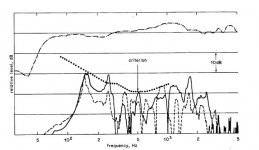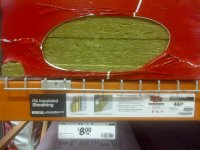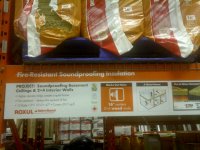Many years ago I made 2 sets of cabinets, 18mm MDF and 18mm 700Kgm/m (flooring grade) chipboard, and to my ears the chipboard pair sounded cleaner. I've also used Finnish Birch and Russian Birch; the Russian was prettier but the Finnish was denser and smoother. I don't know if they would sound different, but I suspect the Finnish would be more rigid.
Speaker Dave, coming back to damping speaker panels, can you elaborate on what is the most effective way to accomplish panel damping?
There is a lot of stuff on the internet, including bitumen pads, asphalt sheets, roofing material, etc. And different mechanisms of applying it. It would be good to know what is most effective with a reasonable amount of effort.
You were talking earlier about mass loaded vinyl, but I couldn't find anything I could buy from a store and check out in a test build.
There is a lot of stuff on the internet, including bitumen pads, asphalt sheets, roofing material, etc. And different mechanisms of applying it. It would be good to know what is most effective with a reasonable amount of effort.
You were talking earlier about mass loaded vinyl, but I couldn't find anything I could buy from a store and check out in a test build.
Above 22kHz, I presume?
Approaching 1000 Hz is usually sufficient.
dave
Speaker Dave, coming back to damping speaker panels, can you elaborate on what is the most effective way to accomplish panel damping?
There is a lot of stuff on the internet, including bitumen pads, asphalt sheets, roofing material, etc. And different mechanisms of applying it. It would be good to know what is most effective with a reasonable amount of effort.
You were talking earlier about mass loaded vinyl, but I couldn't find anything I could buy from a store and check out in a test build.
We played around a fair bit with this at Snell. I was findng that the typical add on materials were not giving enough effect unless the layers were quite thick and massive. This is a follow on from what Harwood was telling us, that damping is more effective when the cabinet walls are thin.
We moved on to try a sandwich approach. I played with a compliant layer between two baffle thicknesses, thinking it could be similar to issolated woofers as had worked well at KEF, but without worrying about specifically tooled chassis to accomodate the issolation mounts. I found the results became very particular to how you tied things together. A compliant inner layer could easily be shorted by tightening the screws too much. Layers needed to be fixed together to define location, but not too fixed. Performance was good but there wan't a simple productions solution.
From there we went to straight constrained layer damping with a lossy rather than highly compliant central layer. For the K5 and E5 (then XA75 and XA90)we used a double baffle with heavy neoprene rubber in the 1 to 2mm thick range. The benefit was that you could screw through it and not degrade the performance. The rubber was much like tyre inner tube material. This seemed to do very well with the "nuckle rap" test.
For the XA reference we found a Swedish material called "noise killer yellow". I think it is still around in car stereo circles. We made samples of MDF with two layers hard glued vs. two layers with a then layer of this material. (thin works better than thick) You tossed them onto the desk top and one made a loud clatter and the other a dull thump. This was used for all sides of the XA Reference.
If I was doing it as a DIYer I would get the noise killer type material of any good brand and add an internal layer to a current cabinet, of either 1/2" MDF, ceramic bathroom tiles, or even masonite as an experiment. Again, you will have better success if your outside layer isn't too thick and stiff to start with. You can just add wall sections that fit through the woofer opening and try to cover 70 -80% of the inside.
The mass loaded vinyl is more of a noise issolation material used by home and office constructors. This is typical:
Mass Loaded Vinyl
I'm not sure if it would work as well inside a cabinet (or even outside) but it would be worth trying. The typical heavy membrane with a foam layer doesn't reduce the vibration of the contacting layer (at least not by damping), but actually turns your issolation wall into a more complex mass, compliance, mass system. All the architectural articles will show that that is the way to get the best TL (transmission loss) between rooms. Having a soft mass for one of the layers gives loss without coincidence effect (resonances of high transmission).
Regards,
David S.
Last edited:
I've seen Sreten suggest vinyl floor tile.You were talking earlier about mass loaded vinyl, but I couldn't find anything I could buy from a store and check out in a test build.
Approaching 1000 Hz is usually sufficient.
dave
You've had better luck than Harwood, who had strong resonances to above 2kHz.
David S.
Attachments
Thanks for all your comments.
Clarification about the bass bin construction: the internal panels toward the rear are 3/4" MDF, the front ones are 3/4" ply. All of the exterior sheathing is 1/2" ply, glued and nailed to the interior. Whole thing is glued and screwed, with every joint cleated, and it's braced to handle trucks driving over it. There is a solid cross (horizontal) brace not shown in the pic. All interior surfaces are lined with 1/2" thick heavy felt. No panel is more than 10" wide (most are much smaller), so I can't see them "ringing" very much. Baffle, top, and bottom are two layers of 3/4" ply. The outer top panel "floats" on a layer of Dynamat between the ply layers (with no nails or screws between them, only glue, so it is true CLD), so it does not transfer ANY vibration to the upper cabs.
There is not an attached concrete base. I apologize for not being clear. Concrete was poured into the bottom of the cab (inside the box), sloped to be thicker toward the rear, and thoroughly mangled to roughen the surface while setting up. It looks like a dog chewed egg carton foam, but concrete and irregular.
Each bass cab weighs 70 - 80 pounds. I wasn't fooling around when I built these, and I don't think they're contributing to the coloration I hear. In fact, they sound pretty good in the midrange when run without the xover. Cannot readily hear ringing (I'm not saying it doesn't; I can't readily hear it, which is what matters) when playing the bass crossed or full range, and I don't feel much vibration of the walls, even with very loud bass playing.
Peace,
Tom E
Amazing design. Still seems like it should ring/resonate in the lower midrange, being so stiff. What I would do, IMHO:
- Make the upper cab's more damp, to move their resonances below their passband
- Make sure the resonances of the bass cabs are above their passband
- More effectively decouple the upper cabs from the lower, I don't think a layer of dynamat is the right thing. Spikes maybe, soft springs, I prefer a large thick layer of foam, or even better an air cushion (inner tube).
For the XA reference we found a Swedish material called "noise killer yellow". I think it is still around in car stereo circles. We made samples of MDF with two layers hard glued vs. two layers with a then layer of this material. (thin works better than thick) You tossed them onto the desk top and one made a loud clatter and the other a dull thump. This was used for all sides of the XA Reference.
If I was doing it as a DIYer I would get the noise killer type material of any good brand and add an internal layer to a current cabinet, of either 1/2" MDF, ceramic bathroom tiles, or even masonite as an experiment. Again, you will have better success if your outside layer isn't too thick and stiff to start with. You can just add wall sections that fit through the woofer opening and try to cover 70 -80% of the inside.
Regards,
David S.
I fully coated the inside of a slat braced, 3/4" 5-ply birch sub box with roofing adhesive, and had it go from a higher pitched ping to a much lower pitched thud.....not quite an mdf thud, but a much stiffer and lighter construction. I am seriously considering building portable system with 1/2" birch, coating it on the inside.
Awesome ideas!
Thanks David and others!
So, it's not important to get the whole panel as long as you get the majority of it. Good.
Regarding the noise killer stuff. How do you attach the bathroom tile or 1/2 inch mdf panel to the outside panel? Is the noise killer stuff adhesive? Or do you need to add adhesive on top of the noise killer?
These may seem stupid questions, but I haven't ever worked with the noise killer stuff.
So, it's not important to get the whole panel as long as you get the majority of it. Good.
Regarding the noise killer stuff. How do you attach the bathroom tile or 1/2 inch mdf panel to the outside panel? Is the noise killer stuff adhesive? Or do you need to add adhesive on top of the noise killer?
These may seem stupid questions, but I haven't ever worked with the noise killer stuff.
I was thinking the extra mass layer would go on the inside rather than outside, primarily for cosmetic reasons. The material is a type of adhesive, so it is all you need. It looks and feels like a type of rubber cement.
I think this is the stuff and it looks like Rockford sells it too.
NEWFOAM - The Speaker Place: Accessories, Noise Killlers, plus more!
The Swedish company:
Noisekiller - Vibratec
David
I think this is the stuff and it looks like Rockford sells it too.
NEWFOAM - The Speaker Place: Accessories, Noise Killlers, plus more!
The Swedish company:
Noisekiller - Vibratec
David
Yes, I meant how do you adhere the inside panel (tile, mdf) to the outside panel  . I won't be putting bathroom tiles on the outside of my speakers
. I won't be putting bathroom tiles on the outside of my speakers  ; not unless they're going in the bathroom.
; not unless they're going in the bathroom.
My searches turned up the same results. Thanks. This is a good start.
One more question: How do you attach fiberglass to the top panel? I'm afraid its going to fall off. Just cut it larger than the width of the panel and get a snug fit? Staples? This is the 50 to 100 mm layer for absorbing the back wave above 500-800 Hz.
My searches turned up the same results. Thanks. This is a good start.
One more question: How do you attach fiberglass to the top panel? I'm afraid its going to fall off. Just cut it larger than the width of the panel and get a snug fit? Staples? This is the 50 to 100 mm layer for absorbing the back wave above 500-800 Hz.
Last edited:
What about RTV? The 100% silicone variety seems very elastic and adheres well.I was thinking the extra mass layer would go on the inside rather than outside, primarily for cosmetic reasons. The material is a type of adhesive, so it is all you need. It looks and feels like a type of rubber cement.
I think this is the stuff and it looks like Rockford sells it too.
NEWFOAM - The Speaker Place: Accessories, Noise Killlers, plus more!
The Swedish company:
Noisekiller - Vibratec
David
I am making isobaric cabs from (Chinese?) birch ply, with 600 x 400 x 15mm limestone panels fixed to the sides, on the outside, partly for mass and partly for looks. I have some of this adhesive left from my floor, so will probably use it. Rewmar MS Polymer Adhesive 12kg - Rewmar It's flexible, to allow for floor expansion; it will be interesting to see (hear) how it works. It's stuck the oak floor to concrete very effectively.
What about RTV? The 100% silicone variety seems very elastic and adheres well.
That would offer compliance but you are really looking more for damping, that the noise killer products are supposed to offer.
There is also a material used by architectural types called green glue.
This is a really good tutorial on acoustical wall performance, but much of it is very pertinent to cabinet construction.
http://www.greenglue.co.uk/greenGlue-vs-MLV.pdf
David S.
One more question: How do you attach fiberglass to the top panel? I'm afraid its going to fall off. Just cut it larger than the width of the panel and get a snug fit? Staples? This is the 50 to 100 mm layer for absorbing the back wave above 500-800 Hz.
I think a heavy duty staple gun will work up to 50mm (press hard before you pull the trigger). For thick material on walls they tend to used long fasteners with fiber washers. Nails or screws with fiber washers would do as well.
I find that the thicker material tends to just stay in place. You can also put some hot melt or construction adhesive behind it.
David S.
As well as the other suggestions, you could always glue/tack/staple some fabric under it to hold it in place. Doesn't need to be anything special, like some cotton scrap, so long as you can breathe through it.One more question: How do you attach fiberglass to the top panel? I'm afraid its going to fall off. Just cut it larger than the width of the panel and get a snug fit? Staples? This is the 50 to 100 mm layer for absorbing the back wave above 500-800 Hz.
Member
Joined 2009
Paid Member
Roxul and other alternatives to fibreglass?
any idea if I can use this stuff instead of fibreglass (my local Home Depot doesn't carry the fibreglass) ?
any idea if I can use this stuff instead of fibreglass (my local Home Depot doesn't carry the fibreglass) ?
Attachments
Last edited:
- Status
- This old topic is closed. If you want to reopen this topic, contact a moderator using the "Report Post" button.
- Home
- Loudspeakers
- Multi-Way
- Best sealed enclosure for completely supressing back wave



